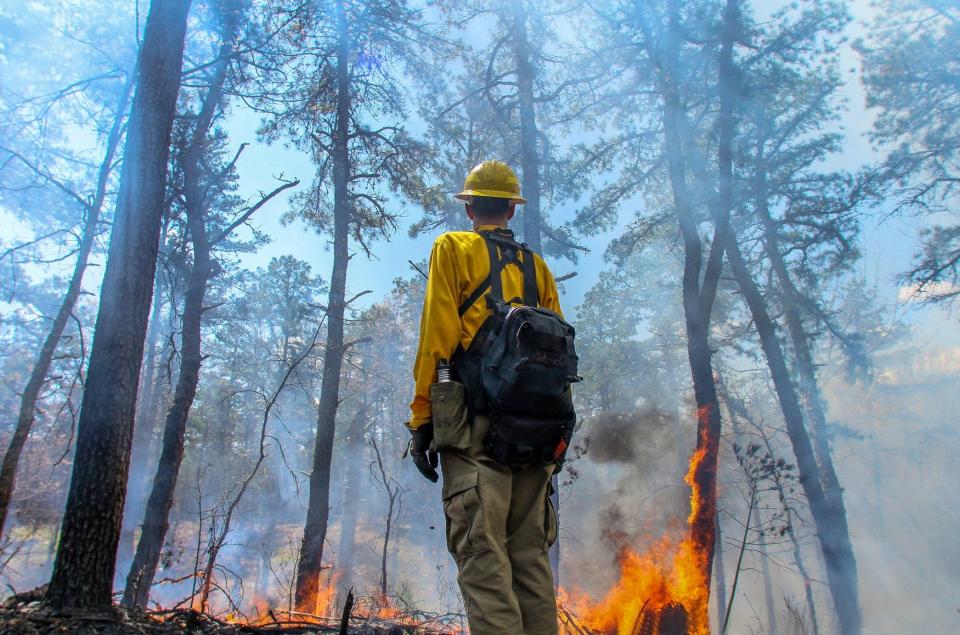DEM will be doing more prescribed burns in these four areas this spring.
PROVIDENCE — It may not necessarily be cause for alarm if you spot smoke rising from a state forest or grassland this spring.
The Rhode Island Department of Environmental Management is stepping up a program of what are known as “prescribed burns,” with the aim of tamping down the threat of extreme fires and restoring native ecosystems.
“One of our goals is to prepare the public that we’ll be burning more,” said DEM spokesman Michael Healey. “We want to try and minimize anxiety and focus on the benefits of this program.”
Those benefits include improving the health of rare woodlands, grassy expanses and other valuable wildlife habitats that have been overrun by invasive plants. The strategic use of fire to clear out deadwood also helps prevent wildfires by reducing the fuel load on the forest floor.
Rhode Island recently started using prescribed burns again
While forest fires aren’t nearly as common in the Northeast as in the western United States, they’re an increasing concern as climate change makes summers hotter and drier. In 2022, a year in which the state suffered an intense drought, there were more than 80 wildland fires in Rhode Island, according to the DEM. The dry conditions forced the agency to ban outdoor fires at all state campgrounds, parks and management areas over a two-week period in August.
More on wildfires:As wildfires rage in California, fire concerns grow in New England amid changing climate
Using prescribed burns to manage forests is an age-old technique that’s commonly used in other parts of the country, but it’s only in recent years that it’s been put to use again on state-owned land in Rhode Island. In 2018, the DEM carried out the first burn in a state forest in a decade, using the controlled application of fire in the Nicholas Farm Management Area in Coventry to restore a threatened pitch pine forest.

Since then, the agency has done a couple of more burns, most recently about a year ago on 40 acres on Dutch Island in Narragansett Bay.
But the efforts in Rhode Island, which totaled some 75 acres, are small compared to neighboring states. From 2018 to 2022, Massachusetts carried out 223 burns over 7,148 acres and Connecticut had 18 burns covering 300 acres.
Doing more in Rhode Island was limited by funding, but with $3 million allocated to forest restoration and management from an environmental bond issue approved by voters in 2022, the DEM now has the money to start expanding its burn program.
Staff training was also an issue, but work on the three burns in Rhode Island, as well as helping out with similar efforts in Connecticut and Massachusetts, over the past five years has helped. DEM employees have also fought wildfires in other parts of the country, building the expertise they need in managing prescribed burns.
More:Race against time: Rising seas push the saltmarsh sparrow to the edge of extinction
Conversely, taking part in managed burns can help when wildfires occur, said Ben Arnold, principal forest ranger and fire program training officer with the DEM.
“If we can use prescribed fire to share resources, when a real wildfire breaks out, it’s going to make that engine run much more smoothly,” said Arnold, who’s fought wildfires in Montana, Colorado and parts of Canada.
The DEM has developed burn plans for four areas in the state: Nicholas Farm; Dutch Island; Pratt Farm, which is part of the Arcadia Management Area in Exeter; and Prudence Island.
They’re all places where natural fires have historically occurred.
“We’re implementing these prescribed fires in areas that call for it,” said Pat MacMeekin, forest fire program manager at the agency.
For example, pitch pine barrens, like the one at Nicholas Farm, are adapted to fire. Fire helps clear out white pines and other tree species that aren’t historically part of the ecosystem, leaving room for pitch pines, which can withstand the flames. Box turtles, which are designated a species of greatest conservation need in Rhode Island, can be found in pine barrens, as well as the rare frosted elfin butterfly.
On Dutch Island, the burn killed off autumn olive, bittersweet and other non-native plants that were choking the landscape. Since then, summer grasses have come back along with milkweed and other plants favored by pollinators.
“The difference between when we started and what it looks like now is pretty drastic,” said DEM habitat biologist John Veale.
This article originally appeared on The Providence Journal: More prescribed burns in RI state forests coming this spring.

